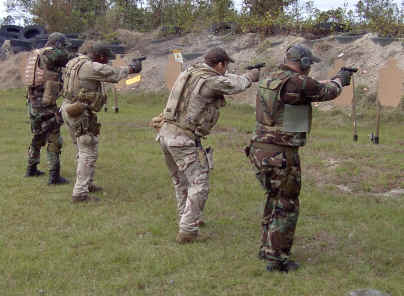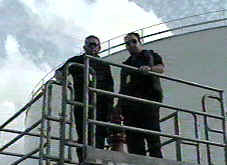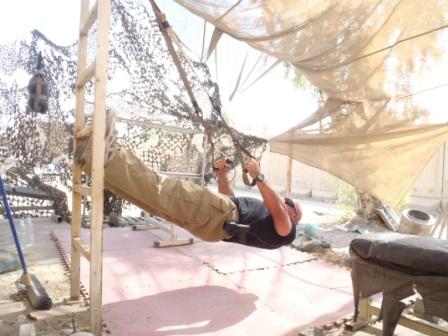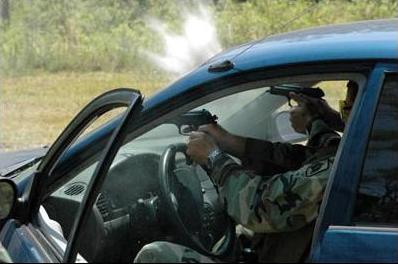








‘Crash’
course for force protection
 |
|
Force Protection Soldiers fire 9-mm pistols through a
windshield during training in Graham, Fla. |
Story and photos by Senior Airman
Thomas Kielbasa
Florida National Guard Public
Affairs
GRAHAM, Fla. – A Hollywood stuntman doesn’t have anything on Sgt. Adam
Anderson.
The Florida National Guard sergeant was among six Soldiers
who took part in a week of specialized anti-terrorism training in late April,
which included learning high-speed driving tactics similar to those seen in
action movies. At a secluded shooting club in west Florida on April 29,
Anderson plowed a beat-up 1979 Chevy Suburban into a parked car at a makeshift
roadblock, fired a 9-mm pistol at targets from a moving truck, and practiced
180-degree turns that would have made James Bond proud.
|
|
|
A Soldier driving a Suburban
crashes through a "road block" during the recent training. |
“I loved crashing the vehicle,” Anderson said after the
ramming exercise where he successfully broke through the roadblock by smashing
into the rear end of a diminutive Ford Escort LX.
The rear quarter panel of the car had crumpled and sent a
hubcap spinning off into the grass; Anderson and the hurtling Suburban skidded
to a stop a less than a hundred feet away.
“That is the first serious car wreck I’ve ever been in,”
Anderson, a member the Florida National Guard’s Force Protection assigned to
Battery A, 1st Battalion, 265th Air Defense Artillery Regiment, explained
later. “It really takes the fear out of getting in a collision like that.”
The Soldiers involved in the week-long class – held at Camp Blanding Joint Training Center and the Bradford Sportsmen’s Club in Graham – were all force protection personnel assigned with providing security for National Guard facilities and personnel in Florida. Since 2001, the Force Protection Soldiers have become familiar sights at armories and National Guard events across the state.
|
|
|
Soldiers react to a "terrorist attack" during
force protection training in Graham, Fla. |
This training – although non-traditional – was aimed at
improving their skills in the event of a terrorist attack against Florida’s
citizen-Soldiers and Airmen.
In another exercise, the Soldiers sat in the front seat of a
car and fired pistols through the windshield at targets beyond the hood. After
a few quick shots and a spray of glass, they exited the car and quickly ran
behind the car – firing all the while. “Every day we’re driving out on the road,” Anderson said,
“…and you never know when something may happen.”
Course
instructor Russ Adler explained the training was a
necessary part of being a Soldier in the post-Sept. 11, 2001
environment. “It increases their confidence, their skills
and their
personal abilities to deter any kind of potential terrorist
threats,” Adler,
whose Lake City, Fla.-based Adler and Associates provided the training.
He noted that some of the advanced driving skills his firm
teaches “are pretty much only found in racecar drivers. We take a
combination
of law enforcement pursuit driving skills and road course race driving
and put
it into a concise package to teach them the most advanced tactics and
techniques.”
In
a shiny 2005 Pontiac Grand Am, Adler ran the National
Guard contingent through a number of driving maneuvers like
“bootleg turns,”
“J-turns,” and high-speed reverse driving. “We
teach them to think outside the box,” he said. “Just
because they are on a road doesn’t mean they have to stay on the
road. They can
take walkways or any means to escape a potential terrorist threat,
attack or
kidnapping.” He demonstrated a scenario where a Soldier
driving a general
officer pulls up to a terrorist roadblock and needs to make a fast
getaway: shift to reverse, speed backwards,
spin the steering wheel to the left, and halfway through the turn shift quickly
into drive, spin back the wheel and accelerate. It’s a flawless 180-degree turn that could save lives in
the right situation. “They are taught to use their vehicle not only as a weapon,
but as a means to escape (a threat) as well,” he added.